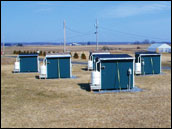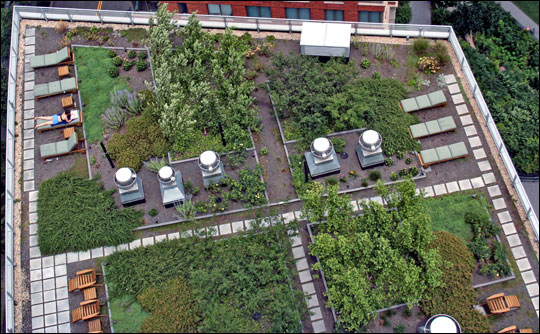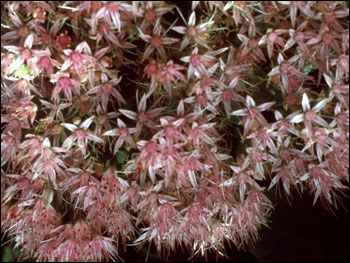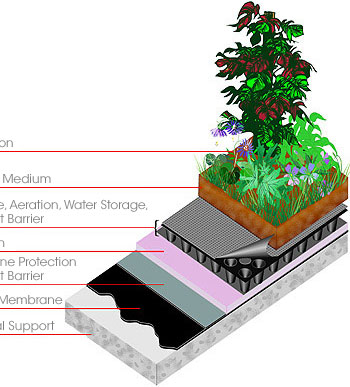

Whites Versus Greens | |||
Anyone who has ever planned to spend hours outside on a hot, sunny day has probably heard the advice to wear light colors. Pale colors reflect much of the Sun’s light, keeping their wearers cool. The same is true for buildings. Gaffin and his colleagues presented the results of their 2002 New York City heat wave study at a science meeting in January 2006, and at that time, he considered white roofs the winning strategy. By April 2006, however, he had changed his mind. |
|||
The study in New York confirmed that white roofs—generally made with the use of a thin, light coating—absorb much less of the Sun’s energy than asphalt roofs, and they are fairly inexpensive and easy to install. But even though white surfaces may be cooler than dark surfaces, they still trap heat. “Just go around your neighborhood. I think you’ll find that lighter urban surfaces are still pretty hot in the summer, compared to plants,” Gaffin says. What’s worse, “in urban settings, white roofs get dirty quickly,” reducing their ability to reflect sunlight. Even when they’re kept clean, white roofs cause problems, he explains. In reflecting the sunlight, they may just bounce much of it off nearby buildings, heating up the immediate area. “You haven’t really gotten the light out of the city,” he says. And in the wintertime, light roofs may cool buildings unnecessarily, increasing heating demands. Light-colored roofs held another drawback for Gaffin. As he researched mitigation options for the urban heat island, he became aware of another issue that causes some cities as much hardship: stormwater runoff. “The purpose of asphalt is to create an impervious surface,” he explains, to keep out water. Unfortunately, the water that can’t be absorbed by roofs and roads has to go somewhere else. To deal with runoff from heavy rains, cities have storm sewers, but many cities use the same systems to handle both the overflow from rainstorms and the water flushed out of toilets. Heavy rains can overwhelm these systems (called combined sewer overflows), pushing raw sewage into waterways. “It’s the major source of pathogens in the New York Harbor. It’s a major problem in Europe. This is one of the impediments to ever reclaiming the recreational and other values of our urban water systems,” he says. He has coined a term for this problem, as a parallel to the urban heat island. He calls it “the urban runoff island.” Light-colored roofs might absorb less of the Sun’s energy than dark roofs, he says, but they do nothing to mitigate runoff. “I’m no fan of white roofs anymore,” Gaffin concludes. “I started this line of research thinking they should be promoted. I finished this research thinking they are a secondary option.” Gaffin would rather promote a solution that addresses both urban heat and urban runoff. If cities don’t have much room for lots of additional trees, and if light-colored roofs only partially reduce urban heat and in no way reduce runoff, just one option remains: vegetation-covered roofs. |

Stuart Gaffin and his collaborators at Pennsylvania State University carried out controlled experiments in the summer of 2003 comparing temperatures on vegetation-covered roofs with temperatures on impervious, dark roofs. (Photo courtesy Stuart Gaffin.) | ||
 | |||
While Gaffin and his colleagues undertook the 2002 New York City study, experiments were already underway at Pennsylvania State University to assess the cooling capabilities of roofs covered with vegetation. In 2003, Gaffin worked with Penn State researchers to compare the temperatures of roofs planted with Sedum spurium to standard dark roofs. “Sedum is a desert-adapted plant with shallow root systems. The plants can tolerate long periods of drought. They’re lush green, beautiful to look at, quite pleasant to touch,” he says. In the arid American Southwest, this cactus-family succulent is a popular landscaping choice for those looking to minimize water use in lawns. |
Green roofs can range in complexity from a shallow layer of soil and plants to more elaborate rooftop garden with trees and shrubs. The more elaborate roofs place greater structural loads on buildings and require more maintenance, so planning and implementing them is more complicated. This photo shows the garden-like green roof atop the Solaire in Battery Park City in New York. (Photo Copyright © birdw0rks/Simon Bird and the Albanese Organization.) | ||

During their rooftop garden project, Gaffin and the Penn State team found that the peak temperatures on the roofs planted with Sedum were 30 degrees Celsius (54 degrees Fahrenheit) lower than the temperatures on standard roofs. They also found that the low-maintenance Sedum plants thrived without any supplemental watering. |
Sedum spurium is a drought-adapted plant often used for low-maintenance green roofs. (Photo Copyright © G.A. Cooper at USDA-NRCS PLANTS Database.) | ||
 | |||
Despite Gaffin’s confidence in green roofs, he knows their implementation could be complicated. “A lot of people think green roofs are going to cause problems, that they’re going to leak or fall apart,” he says, “but it’s just the opposite. They actually leak less. There are [green] roofs in Europe that last 30, 40, 50 years, or more.” Longevity, however, comes at a price. “We spend a lot of time on the economics of green roofs. They’re expensive, and we’re trying to see how to bring the costs down. Part of the problem is that we don’t have a mature industry here in the United States. It’s still a somewhat specialized construction procedure.” Vegetation-covered roofs typically include the following layers: a waterproof membrane at the bottom, a layer of drainage materials, a root-repellant and filter layer, a lightweight soil-like growing medium, and finally the plants. Compared to standard roofs, green roofs do have more mass, but thin systems of only 3 to 4 inches (7.5 to 10 centimeters) are sufficient. When they are saturated with rainwater, they may create a load of 1,197 pascals (about 25 pounds per square foot), which is often feasible for many city buildings. By evaporating moisture, the plants release heat without raising local temperatures. Likewise, the plants and soil soak up rainfall like a sponge instead of letting it roll right off the surface. |
During the Penn State 2003 study, Gaffin and his collaborators measured the temperatures on both green and dark roofs. Both kinds of roofs warmed during the day and cooled overnight. While dark roofs cooled slightly more overnight, however, they warmed up much more during the day than their green counterparts. At their warmest, the dark roofs reached roughly 70 degrees Celsius, whereas the green roofs only reached about 40 degrees. (Graph courtesy Stuart Gaffin.) | ||
 |

If green roofs do provide a sound solution to urban heat and runoff islands, they may need to be implemented differently in different places. The experiments in Pennsylvania showed that Sedum could thrive without irrigation, but Pennsylvania is more humid and rainy than other parts of the world. Places like sub-Saharan Africa and northwestern China are vulnerable to severe, prolonged droughts. Even gardeners in the American Southwest run into difficulties. Horticulturalist Panayoti Kelaidis is the director of outreach for Denver Botanic Gardens. Like Gaffin, he admires the green roof concept and the drought-tolerant succulent Sedum. But Kelaidis doubts green roofs could succeed in an arid climate without supplemental watering. Switching to less thirsty plants wouldn’t necessarily solve the problem. “Some plants take even less water than Sedum. Some plants grow in saltpans. They could practically grow on the surface of the Moon,” Kelaidis says. Such plants respond to protracted dry spells, however, by going dormant. “The downside is that their biotic activity is so minimal when they are dormant, they’re no better than asphalt.” That doesn’t mean he thinks green roofs are doomed to failure, but he does think irrigation systems would be required. “Even modest irrigation would work. Just a mist of water would be enough.” So in the driest climates, the ideal green roof might require an irrigation system, and overcoming the expense of implementing green roofs may slow their adoption. But as temperatures rise, the green roofs’ potential to cool cities remains attractive. Recent heat wave tolls show the gravity of warming temperatures. The Chicago heat wave of 1995 claimed more than 700 lives. The record-warm European summer of 2003 claimed between 22,000 and 45,000 lives. “Can we air condition our way out of these heat waves? Not always,” Gaffin says. “So how can we cool these cities down? There aren’t many strategies we can choose. But green roofing looks like a great way to alleviate these problems.”
|
Although longer-lived than a standard roof, a vegetation-covered roof is more complex, and its components mitigate both urban heat and urban runoff. Water that would otherwise reach a storm sewer is trapped by the green roof’s soil and vegetation. (Image Copyright © American Wick Drain Corporation.) | |